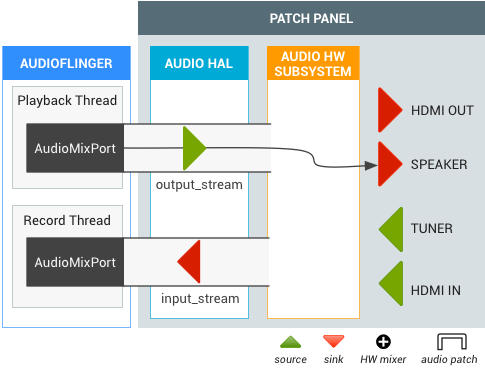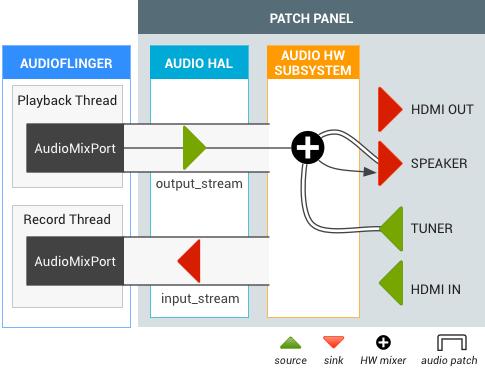टीवी इनपुट फ़्रेमवर्क (टीआईएफ़) मैनेजर, ऑडियो रूटिंग एपीआई के साथ काम करता है, ताकि ऑडियो पाथ में आसानी से बदलाव किए जा सकें. जब सिस्टम ऑन चिप (SoC) टीवी हार्डवेयर एब्स्ट्रैक्शन लेयर (एचएएल) को लागू करता है, तो हर टीवी इनपुट (एचडीएमआई इन, ट्यूनर वगैरह) TvInputHardwareInfo उपलब्ध कराता है. इससे ऑडियो टाइप और पते के लिए, ऑडियोपोर्ट की जानकारी मिलती है.
- फ़िज़िकल ऑडियो इनपुट/आउटपुट डिवाइसों में, उससे जुड़ा AudioPort होता है.
- सॉफ़्टवेयर ऑडियो आउटपुट/इनपुट स्ट्रीम को AudioMixPort (AudioPort की चाइल्ड क्लास) के तौर पर दिखाया जाता है.
इसके बाद, TIF, ऑडियो रूटिंग एपीआई के लिए AudioPort की जानकारी का इस्तेमाल करता है.

पहली इमेज. टीवी इनपुट फ़्रेमवर्क (टीआईएफ़)
ज़रूरी शर्तें
किसी SoC को ऑडियो एचएएल को लागू करना होगा. इसके लिए, ऑडियो रूटिंग एपीआई के साथ इनका इस्तेमाल करना होगा:
| ऑडियो पोर्ट |
|
|---|---|
| डिफ़ॉल्ट इनपुट | Android TV पर AUDIO_DEVICE_IN_DEFAULT हासिल करने के लिए, AudioRecord (DEFAULT इनपुट सोर्स से बनाया गया) को वर्चुअल नॉल इनपुट सोर्स को जब्त करना होगा. |
| डिवाइस लूपबैक | इसके लिए, AUDIO_DEVICE_IN_LOOPBACK इनपुट की ज़रूरत होती है. यह टीवी के सभी आउटपुट (11 किलोहर्ट्ज़, 16 बिट मोनो या 48 किलोहर्ट्ज़, 16 बिट मोनो) के सभी ऑडियो आउटपुट का पूरा मिक्स होता है. इसका इस्तेमाल सिर्फ़ ऑडियो कैप्चर करने के लिए किया जाता है. |
टीवी के ऑडियो डिवाइस
Android, टीवी के ऑडियो इनपुट/आउटपुट के लिए इन ऑडियो डिवाइसों के साथ काम करता है.
system/media/audio/include/system/audio.h
ध्यान दें: Android 5.1 और उससे पहले के वर्शन में, इस फ़ाइल का पाथ यह है: system/core/include/system/audio.h
/* output devices */ AUDIO_DEVICE_OUT_AUX_DIGITAL = 0x400, AUDIO_DEVICE_OUT_HDMI = AUDIO_DEVICE_OUT_AUX_DIGITAL, /* HDMI Audio Return Channel */ AUDIO_DEVICE_OUT_HDMI_ARC = 0x40000, /* S/PDIF out */ AUDIO_DEVICE_OUT_SPDIF = 0x80000, /* input devices */ AUDIO_DEVICE_IN_AUX_DIGITAL = AUDIO_DEVICE_BIT_IN | 0x20, AUDIO_DEVICE_IN_HDMI = AUDIO_DEVICE_IN_AUX_DIGITAL, /* TV tuner input */ AUDIO_DEVICE_IN_TV_TUNER = AUDIO_DEVICE_BIT_IN | 0x4000, /* S/PDIF in */ AUDIO_DEVICE_IN_SPDIF = AUDIO_DEVICE_BIT_IN | 0x10000, AUDIO_DEVICE_IN_LOOPBACK = AUDIO_DEVICE_BIT_IN | 0x40000,
ऑडियो एचएएल एक्सटेंशन
ऑडियो रूटिंग एपीआई के लिए ऑडियो एचएएल एक्सटेंशन को इनके हिसाब से तय किया जाता है:
system/media/audio/include/system/audio.h
ध्यान दें: Android 5.1 और उससे पहले के वर्शन में, इस फ़ाइल का पाथ यह है: system/core/include/system/audio.h
/* audio port configuration structure used to specify a particular configuration of an audio port */
struct audio_port_config {
audio_port_handle_t id; /* port unique ID */
audio_port_role_t role; /* sink or source */
audio_port_type_t type; /* device, mix ... */
unsigned int config_mask; /* e.g. AUDIO_PORT_CONFIG_ALL */
unsigned int sample_rate; /* sampling rate in Hz */
audio_channel_mask_t channel_mask; /* channel mask if applicable */
audio_format_t format; /* format if applicable */
struct audio_gain_config gain; /* gain to apply if applicable */
union {
struct audio_port_config_device_ext device; /* device specific info */
struct audio_port_config_mix_ext mix; /* mix specific info */
struct audio_port_config_session_ext session; /* session specific info */
} ext;
};
struct audio_port {
audio_port_handle_t id; /* port unique ID */
audio_port_role_t role; /* sink or source */
audio_port_type_t type; /* device, mix ... */
unsigned int num_sample_rates; /* number of sampling rates in following array */
unsigned int sample_rates[AUDIO_PORT_MAX_SAMPLING_RATES];
unsigned int num_channel_masks; /* number of channel masks in following array */
audio_channel_mask_t channel_masks[AUDIO_PORT_MAX_CHANNEL_MASKS];
unsigned int num_formats; /* number of formats in following array */
audio_format_t formats[AUDIO_PORT_MAX_FORMATS];
unsigned int num_gains; /* number of gains in following array */
struct audio_gain gains[AUDIO_PORT_MAX_GAINS];
struct audio_port_config active_config; /* current audio port configuration */
union {
struct audio_port_device_ext device;
struct audio_port_mix_ext mix;
struct audio_port_session_ext session;
} ext;
};
hardware/libhardware/include/hardware/audio.h
struct audio_hw_device {
:
/**
* Routing control
*/
/* Creates an audio patch between several source and sink ports.
* The handle is allocated by the HAL and should be unique for this
* audio HAL module. */
int (*create_audio_patch)(struct audio_hw_device *dev,
unsigned int num_sources,
const struct audio_port_config *sources,
unsigned int num_sinks,
const struct audio_port_config *sinks,
audio_patch_handle_t *handle);
/* Release an audio patch */
int (*release_audio_patch)(struct audio_hw_device *dev,
audio_patch_handle_t handle);
/* Fills the list of supported attributes for a given audio port.
* As input, "port" contains the information (type, role, address etc...)
* needed by the HAL to identify the port.
* As output, "port" contains possible attributes (sampling rates, formats,
* channel masks, gain controllers...) for this port.
*/
int (*get_audio_port)(struct audio_hw_device *dev,
struct audio_port *port);
/* Set audio port configuration */
int (*set_audio_port_config)(struct audio_hw_device *dev,
const struct audio_port_config *config);
DEVICE_IN_LOOPBACK की जांच करना
टीवी मॉनिटरिंग के लिए DEVICE_IN_LOOPBACK की जांच करने के लिए, टेस्टिंग के लिए इस्तेमाल किए जाने वाले इस कोड का इस्तेमाल करें. जांच करने के बाद, रिकॉर्ड किया गया ऑडियो /sdcard/record_loopback.raw में सेव हो जाता है. यहां FFmpeg का इस्तेमाल करके, ऑडियो को सुना जा सकता है.
<uses-permission android:name="android.permission.MODIFY_AUDIO_ROUTING" />
<uses-permission android:name="android.permission.WRITE_EXTERNAL_STORAGE" />
AudioRecord mRecorder;
Handler mHandler = new Handler();
int mMinBufferSize = AudioRecord.getMinBufferSize(RECORD_SAMPLING_RATE,
AudioFormat.CHANNEL_IN_MONO,
AudioFormat.ENCODING_PCM_16BIT);;
static final int RECORD_SAMPLING_RATE = 48000;
public void doCapture() {
mRecorder = new AudioRecord(MediaRecorder.AudioSource.DEFAULT, RECORD_SAMPLING_RATE,
AudioFormat.CHANNEL_IN_MONO, AudioFormat.ENCODING_PCM_16BIT, mMinBufferSize * 10);
AudioManager am = (AudioManager) getSystemService(Context.AUDIO_SERVICE);
ArrayList<AudioPort> audioPorts = new ArrayList<AudioPort>();
am.listAudioPorts(audioPorts);
AudioPortConfig srcPortConfig = null;
AudioPortConfig sinkPortConfig = null;
for (AudioPort audioPort : audioPorts) {
if (srcPortConfig == null
&& audioPort.role() == AudioPort.ROLE_SOURCE
&& audioPort instanceof AudioDevicePort) {
AudioDevicePort audioDevicePort = (AudioDevicePort) audioPort;
if (audioDevicePort.type() == AudioManager.DEVICE_IN_LOOPBACK) {
srcPortConfig = audioPort.buildConfig(48000, AudioFormat.CHANNEL_IN_DEFAULT,
AudioFormat.ENCODING_DEFAULT, null);
Log.d(LOG_TAG, "Found loopback audio source port : " + audioPort);
}
}
else if (sinkPortConfig == null
&& audioPort.role() == AudioPort.ROLE_SINK
&& audioPort instanceof AudioMixPort) {
sinkPortConfig = audioPort.buildConfig(48000, AudioFormat.CHANNEL_OUT_DEFAULT,
AudioFormat.ENCODING_DEFAULT, null);
Log.d(LOG_TAG, "Found recorder audio mix port : " + audioPort);
}
}
if (srcPortConfig != null && sinkPortConfig != null) {
AudioPatch[] patches = new AudioPatch[] { null };
int status = am.createAudioPatch(
patches,
new AudioPortConfig[] { srcPortConfig },
new AudioPortConfig[] { sinkPortConfig });
Log.d(LOG_TAG, "Result of createAudioPatch(): " + status);
}
mRecorder.startRecording();
processAudioData();
mRecorder.stop();
mRecorder.release();
}
private void processAudioData() {
OutputStream rawFileStream = null;
byte data[] = new byte[mMinBufferSize];
try {
rawFileStream = new BufferedOutputStream(
new FileOutputStream(new File("/sdcard/record_loopback.raw")));
} catch (FileNotFoundException e) {
Log.d(LOG_TAG, "Can't open file.", e);
}
long startTimeMs = System.currentTimeMillis();
while (System.currentTimeMillis() - startTimeMs < 5000) {
int nbytes = mRecorder.read(data, 0, mMinBufferSize);
if (nbytes <= 0) {
continue;
}
try {
rawFileStream.write(data);
} catch (IOException e) {
Log.e(LOG_TAG, "Error on writing raw file.", e);
}
}
try {
rawFileStream.close();
} catch (IOException e) {
}
Log.d(LOG_TAG, "Exit audio recording.");
}
/sdcard/record_loopback.raw में कैप्चर की गई ऑडियो फ़ाइल ढूंढें और FFmpeg का इस्तेमाल करके उसे सुनें:
adb pull /sdcard/record_loopback.rawffmpeg -f s16le -ar 48k -ac 1 -i record_loopback.raw record_loopback.wavffplay record_loopback.wav
इस्तेमाल के उदाहरण
इस सेक्शन में, टीवी ऑडियो के इस्तेमाल के सामान्य उदाहरण शामिल हैं.
स्पीकर आउटपुट वाला टीवी ट्यूनर
जब कोई टीवी ट्यूनर चालू होता है, तो ऑडियो रूटिंग एपीआई, ट्यूनर और डिफ़ॉल्ट आउटपुट (जैसे, स्पीकर) के बीच एक ऑडियो पैच बनाता है. ट्यूनर आउटपुट को डिकोड करने की ज़रूरत नहीं होती, लेकिन आखिरी ऑडियो आउटपुट को सॉफ़्टवेयर output_stream के साथ मिक्स किया जाता है.

दूसरी इमेज. स्पीकर आउटपुट वाले टीवी ट्यूनर के लिए ऑडियो पैच.
लाइव टीवी के दौरान एचडीएमआई आउट
कोई उपयोगकर्ता लाइव टीवी देख रहा है और फिर एचडीएमआई ऑडियो आउटपुट (Intent.ACTION_HDMI_AUDIO_PLUG) पर स्विच करता है . सभी output_streams का आउटपुट डिवाइस, HDMI_OUT पोर्ट में बदल जाता है. साथ ही, TIF मैनेजर, मौजूदा ट्यूनर ऑडियो पैच के सिंक पोर्ट को HDMI_OUT पोर्ट में बदल देता है.

तीसरी इमेज. लाइव टीवी से एचडीएमआई आउट के लिए ऑडियो पैच.

